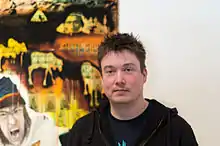Anders Sunna
Börje Karl Anders Sunna (born 11 April 1985) is a Swedish Sámi artist known for incorporating a strong political point of view into his artwork. Sunna was born in the Jukkasjärvi parish of Kiruna, Norrbotten County, Sweden. He grew up in a reindeer herding family in Kieksiäisvaara near the border of Finland and was educated at Academy of Fine Arts, Umeå and the Konstfack University of Arts, Crafts and Design. Nowadays he lives in Jokkmokk, Sweden.

Anders Sunna | |
|---|---|
 Anders Sunna at the opening of an exhibition at the Västerbottens Museum in 2016. Partially visible behind him is his painting "Indigenous Love". | |
| Born | April 11, 1985 |
| Nationality | Swedish |
| Website | anderssunna |
Sunna's art is political, often focusing on Sámi history and his family's long-standing conflict with the county administrative board's reindeer husbandry delegation.[1] In his work, Sunna uses thick layers of color, graffiti techniques, collage, and prints with motifs depicting oppression of the Sámi, including forced relocations and photographs from the Swedish State Institute for Racial Biology.[2] In 2013, Sunna drew criticism from some Sámi for his use of the Sámi flag as a canvas for a graffiti-style painting of a skull-faced Sámi man holding an AK-47.[3]
In addition to painting, Sunna works with larger installations. In some exhibitions, he collaborates with the artist and photographer Michiel Brouwer.[4]
Sunna co-directed with Inga-Wiktoria Påve the 2017 animated short film Morit Elena Morit! (Wake Up Elena Wake Up!), which won the Jane Glassco Award for Emerging Talent at the 2017 imagineNATIVE Film and Media Arts Festival in Toronto and Best Indigenous Short Film award at the 2018 Skábmagovat Film Festival in Finland.[5]
Some of Sunna's art is on public display at the Gällivare District courthouse, after being purchased by the Swedish Arts Council in 2015.[6] Sunna is one of the artists representing Sápmi in the Nordic pavilion during the 2022 Venice Biennale.[7]
Selected exhibitions
A partial list of solo and group exhibitions featuring Sunna's work.
- Sámi Pavilion, 59th Venice Biennale, Venice, Italy — 2022
- Varje löv är ett öga with Michiel Brouwer, Göteborgs Konsthall, Gothenburg, Sweden — 2019–2020
- Modernautställningen, Moderna Museet, Stockholm, Sweden — 2018
- Maadtoe with Michiel Brouwer, Kristinehamns konstmuseum, Kristinehamn, Sweden — 2016–2017
- SAAMELAISTA nykytaidetta = Dálá SÁMI dáidda = SÁMI Contemporary travelling exhibition, 7 March 2014 – 27 September 2015
- Rovaniemi Art Museum, Korundi, Finland — 7 March – 25 May 2014
- Norrbottens Museum, Luleå, Sweden — 18 June – 24 August 2014
- Sami Center for Contemporary Art, Karasjok, Norway — 14 November 2014 – 4 January 2015
- Felleshus, Berlin, Germany — 9 July – 27 September 2015
- Area Infected, Bildmuseet, Umeå, Sweden — 2014
- Institut Tessin, Paris, France — 2014
- Greetings from Sápmi, Jamtli, Östersund, Sweden — 2013
- Norrbottens Ambassad för Konst, Stockholm, Sweden — 2013
- Liljevalchs konsthall, Stockholm, Sweden — 2012
References
- Alm, Helene (8 April 2013). "Sunna mot staten - med konsten som vapen" [Sunna Against the State — With Art as a Weapon]. Kulturdokumentären (in Swedish). Sveriges Radio. Retrieved 10 February 2022.
- Andersson, Camilla (2013). "Anders Sunnas konst lämnar ingen oberörd" [Anders Sunna’s Art Leaves No-One Feeling Indifferent]. Samer (in Swedish). Retrieved 10 February 2022.
- Larsen, Dan Robert (25 October 2013). "— Galt å grise til sameflagget" [— It's Wrong to Deface the Sámi Flag]. NRK Sápmi (in Norwegian). Retrieved 10 February 2022.
- Hjertström Lappalainen, Lars-Erik (21 December 2016). "Kampen tecknad i eld" [The First Drawn in Fire]. Kunstkritikk (in Swedish). Retrieved 10 February 2022.
- Torikka, Xia (27 January 2018). "Animaatiot pärjäsivät alkuperäiskansojen elokuvafestivaalilla – Skábmagovat-palkinnot jaettiin ensimmäistä kertaa" [Animations make it to the Indigenous Film Festival - Skábmagovat awards presented for the first time]. Yle (in Finnish). Retrieved 11 February 2022.
- Östman, Anna (21 November 2014). "Tjakttja – Anders Sunna" [Autum – Anders Sunna]. Minabibliotek (in Swedish and Ume Sami). Archived from the original on 10 November 2015. Retrieved 10 February 2022.
- Niia, Marie-Louise; Stenberg Partapuoli, Ann Catrin; Karlsson, Stefan (14 October 2020). "Sápmi tar över den nordiska paviljongen vid konstbiennalen i Venedig 2022" [Sápmi will take over the Nordic pavilion at the Venice Art Biennale in 2022]. SVT Nyheter (in Swedish). Retrieved 10 February 2022.